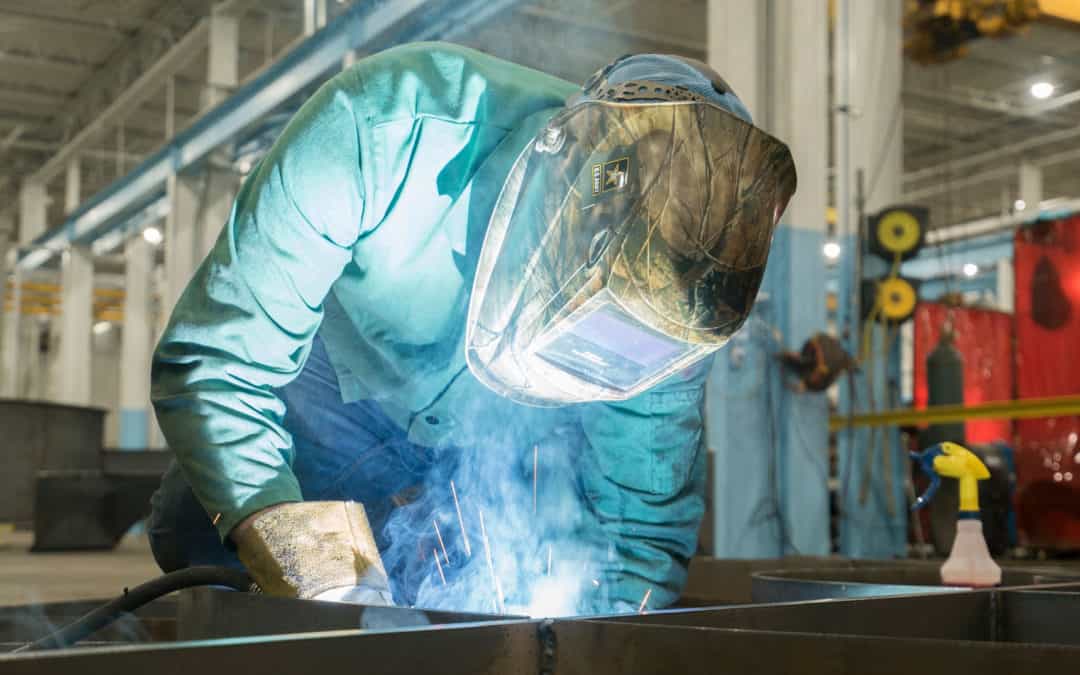
by Erin Long | Apr 2, 2019 | Weld Fume
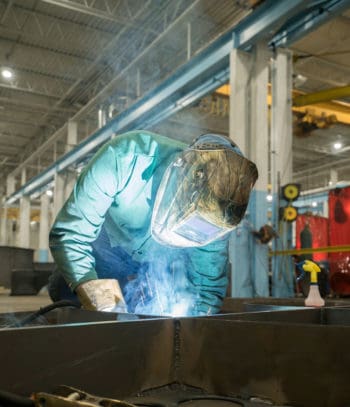 About the School and Their Challenge
About the School and Their Challenge
Located in northern Texas, the Community College offers comprehensive two-year educational programs – including a welding technology program. The school offers Associate of Art, Associate of Science, and Associate of Applied Science Degrees. The Welding Technology Program was interested in more cost-effective cartridge filters for welding fume in their Lincoln Statiflex 6000 dust collector.
Solution: DeltaMAXX Filters for Welding Fume
An Imperial Systems aftermarket member was making daily cold calls to businesses in the industrial realm. They struck a sale with the community college while talking with the instructor of the Welding Technology Program. The aftermarket member learned that the school was shopping around for replacement dust collector cartridge filters for the upcoming school year. Due to the budget, it was a top priority that the filters for welding fume were cost-effective and reliable.
After reviewing the DeltaMAXX filter literature and cross-referencing the filters on Imperial System’s website, the welding technology instructor purchased four DeltaMAXX replacement cartridge filters for the upcoming school year.
Results Beyond Customer Expectations
After running the filters in the dust collector for the fall semester, the welding school instructor was “really impressed” with the DeltaMAXX Replacement Dust Collector Filters.
“The System is running very smooth, not much back blow. When turning on the dust collector in the past we have had problems with smoke blowing out of the back. That problem went away when we installed the DeltaMAXX filters”, said the Texas welding school instructor.
“Imperial Systems’ dust collector filters for welding fume are very durable and they are lasting much longer for us. My expectations were exceeded and you can count on us to be a returning customer.”
Learn more about how Imperial Systems can provide better performing, long-lasting replacement cartridge filters for your existing dust collector. Contact us today.
Read more
by Erin Long | Mar 25, 2019 | Uncategorized
Does everything with your dust collector look like it’s working properly? That doesn’t mean there aren’t problems you can’t see. Dust collector valves are often the culprits of hidden costs due to internal damage.
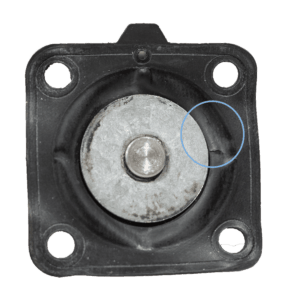 In this photo, the diaphragm from a valve clearly has a crack in the material. Although the system appears to be working perfectly, compressed air escapes through this crack. As a result, this dust collector valve is not getting sufficient air. While this might not be a major problem at first, it’s going to become one.
In this photo, the diaphragm from a valve clearly has a crack in the material. Although the system appears to be working perfectly, compressed air escapes through this crack. As a result, this dust collector valve is not getting sufficient air. While this might not be a major problem at first, it’s going to become one.
Because of this damaged valve, the filter that it’s cleaning is getting less compressed air than the other filters. So, each pulse is not fully cleaning it. That means that filter is going to blind off and need replacement sooner, costing you money. Multiple small valve leaks can have a major impact on shortening the life of your filters.
Springing for New Dust Collector Valves
The following photo is from a ServiceMAXX visit for a problem completely unrelated to the diaphragm valves. However, when our technician did a routine inspection of the valves, he found a problem. The springs inside of them had completely fallen apart:
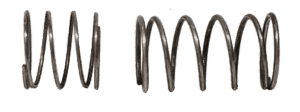 The broken pieces of spring were wreaking havoc inside the valve. They were damaging the valve itself and even starting to scrape and deform the metal parts. The company had no idea this issue was going on because the valves had not failed yet. Fortunately, a routine inspection discovered the broken springs and valve damage. So they replaced the valves before they could fail and wreck the filters. Further, it prevented downtime and thus, more problems.
The broken pieces of spring were wreaking havoc inside the valve. They were damaging the valve itself and even starting to scrape and deform the metal parts. The company had no idea this issue was going on because the valves had not failed yet. Fortunately, a routine inspection discovered the broken springs and valve damage. So they replaced the valves before they could fail and wreck the filters. Further, it prevented downtime and thus, more problems.
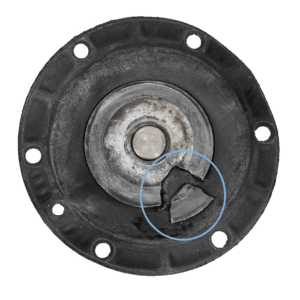 Valves are just one of many things that a ServiceMAXX technician can check. And a damaged valve like this one highlights the value of routine maintenance. Just like your doctor recommends routine bloodwork to catch problems before you see symptoms or a vehicle inspection can reveal wear and tear on engine parts, a yearly ServiceMAXX maintenance visit can find potential problems and fix them before they start to cost you money.
Valves are just one of many things that a ServiceMAXX technician can check. And a damaged valve like this one highlights the value of routine maintenance. Just like your doctor recommends routine bloodwork to catch problems before you see symptoms or a vehicle inspection can reveal wear and tear on engine parts, a yearly ServiceMAXX maintenance visit can find potential problems and fix them before they start to cost you money.
We’re Dying to Find Leaks!
Another ServiceMAXX option is a dye test. In this test, a harmless fluorescent powder runs through the dust collection system, which is then inspected with ultraviolet light. The powder glows brightly. If everything is working properly, the glow will be seen only on the outside of the filters, on the dirty air side of the collector. Any glow on the clean air side means that the dye and other dust is getting through a leak somewhere. This test identifies even very small holes in filters that can’t otherwise be seen.
ServiceMAXX technicians can also perform many other services. Please contact us to schedule a ServiceMAXX visit or a yearly maintenance program. A yearly scheduled maintenance program will give you priority scheduling during times when our technicians are very busy, and makes sure your system is always running at maximum efficiency.
Read more
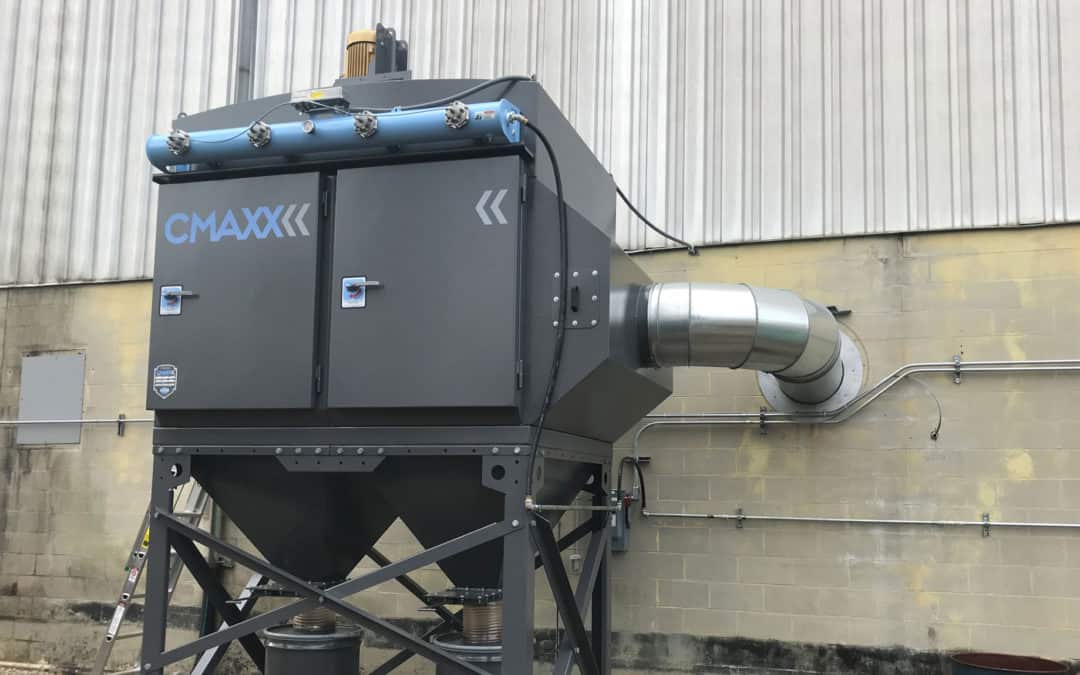
by Erin Long | Mar 15, 2019 | Uncategorized
In January 2019, a facility in Indiana reported an aluminum fire. The company produces aluminum alloys for the auto industry. The fire resulted from highly combustible aluminum dust that had accumulated in the building.
The facility had a sprinkler system that certainly helped keep the fire from becoming an explosion. Fortunately, all the employees escaped without injury. Every facility that handles combustible material can take some advice from this incident.
What Caused the Accident?
Aluminum dust has a high Kst value, meaning that it can cause a very strong explosion. Because of how destructive an aluminum fire can be, take precautions to control and remove aluminum dust.
 This facility has a dust collector. But aluminum dust had still accumulated around the building, especially on overhead beams. During routine cleanings, one can miss dust from flat surfaces in high places that accumulate it.
This facility has a dust collector. But aluminum dust had still accumulated around the building, especially on overhead beams. During routine cleanings, one can miss dust from flat surfaces in high places that accumulate it.
In the Indiana facility, they could not determine where the dust found an ignition source. First, it spread from an area near a furnace, igniting combustible aluminum dust that had accumulated in the area. Then the aluminum fire continued to spread by igniting dust piled up on the ceiling beams.
Their sprinkler system did activate. As a result, this probably prevented a dangerous explosion by keeping the dust from forming an airborne cloud. However, the fire burning on the overhead beams was above the sprinkler system.
From the overhead beams, the aluminum fire was able to spread and reached the dust collector. This caught on fire and burned until the fire department could extinguish it.
Recommendations for Prevention of an Aluminum Fire
Like many combustible dust incidents, this aluminum fire resulted from poor housekeeping. Accumulated dust in a facility can find an ignition source from a spark, faulty wiring, or machines. With a high Kst dust like aluminum, the dust can certainly cause an explosion.
The explosion can cause disturbed layers of dust to become airborne. Consequently, this leads to secondary explosions which can be devastating. However, in this aluminum fire, the dust on the beams did not get a chance to turn into a dust cloud.
Outdoor Installation
This aluminum dust did burn and continue to spread the fire throughout the building and into the dust collector. Fortunately, the collector was located outside the building. With highly combustible dust, it’s almost always the recommendation to locate the collector outside. If an explosion does happen in the dust collector, it will vent away from the building and people inside.
Safety Features
Dust with a high Kst value like aluminum requires a dust collection system with fire and explosion prevention. This company had a sprinkler system in the building. But even after the sprinkler system triggered, nothing stopped the fire from entering the dust collector. Since an explosion wasn’t reported, the collector probably had explosion vent panels or some other safety features.
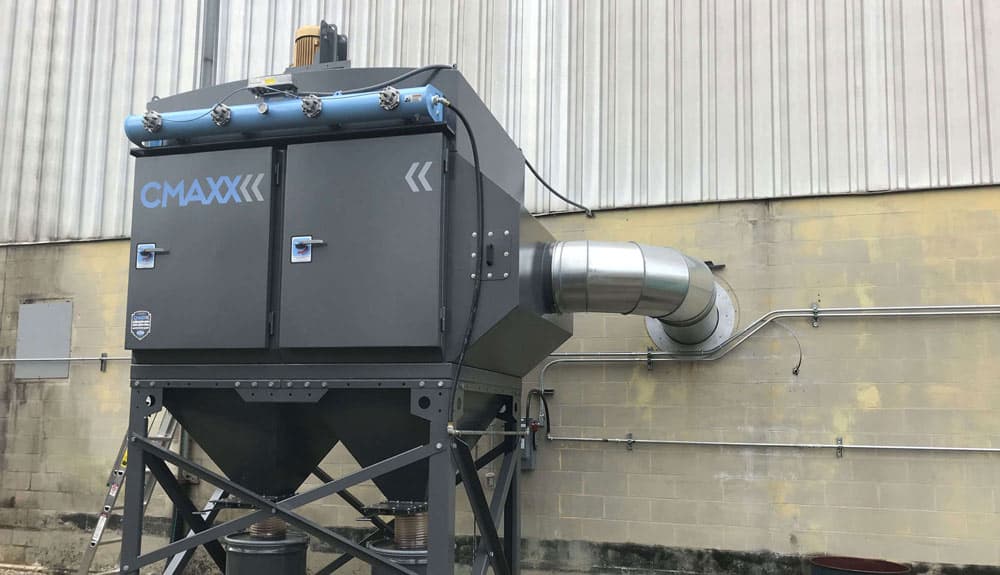
Housekeeping
The most basic recommendation to prevent an aluminum fire, or any other dust fire, is good housekeeping. This means making sure there is no dust buildup around the building. So check and remove any dust from high surfaces like beams.
A dust collection system prevents a buildup of dust in the facility by capturing and removing it. This company had a dust collector, but it clearly could not handle all the dust being produced. An experienced dust collection system designer will make sure your system can capture all the dust your processes create.
The
CMAXX Dust & Fume Collector can meet all your company’s dust collection needs. With an Imperial Systems system designer working with you, your system will be able to handle even highly
combustible dust like aluminum. This will keep your building and workers safe.
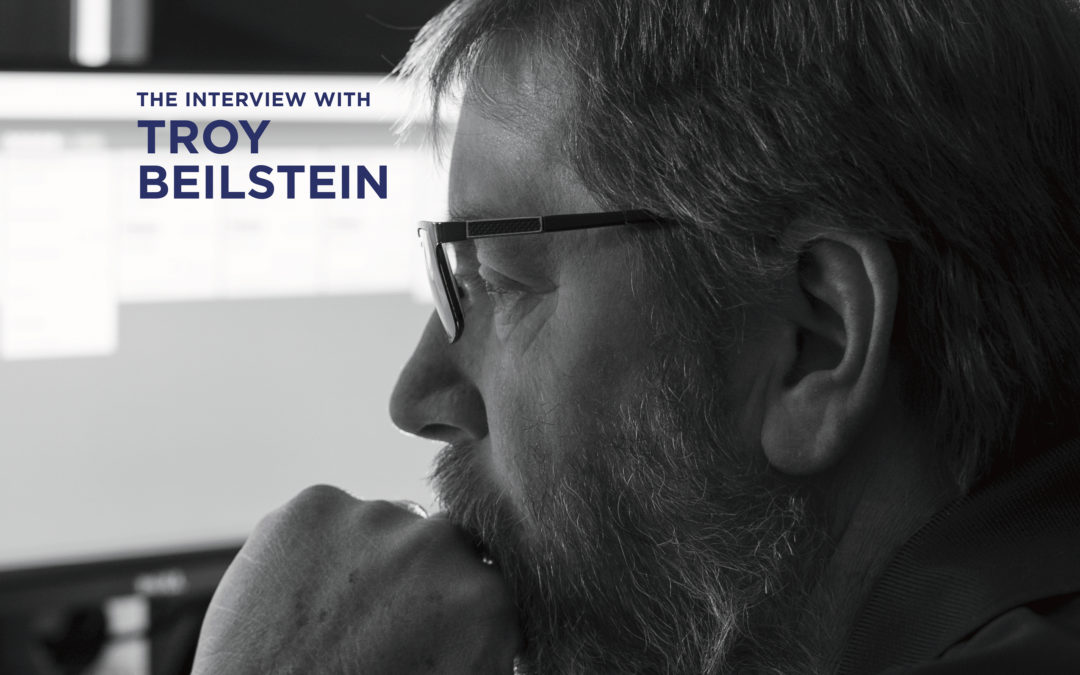
by Erin Long | Mar 5, 2019 | Uncategorized
Dusty Jobs Issue 8 is here! Charlie teaches us a card game, we talk about our latest new product, the Rhino Drum, and we interview one of our engineers. If you would like a printed hard copy of this issue of the quarterly newsletter, contact your Imperial System Sales Rep.
Click the cover to download and print the newsletter.
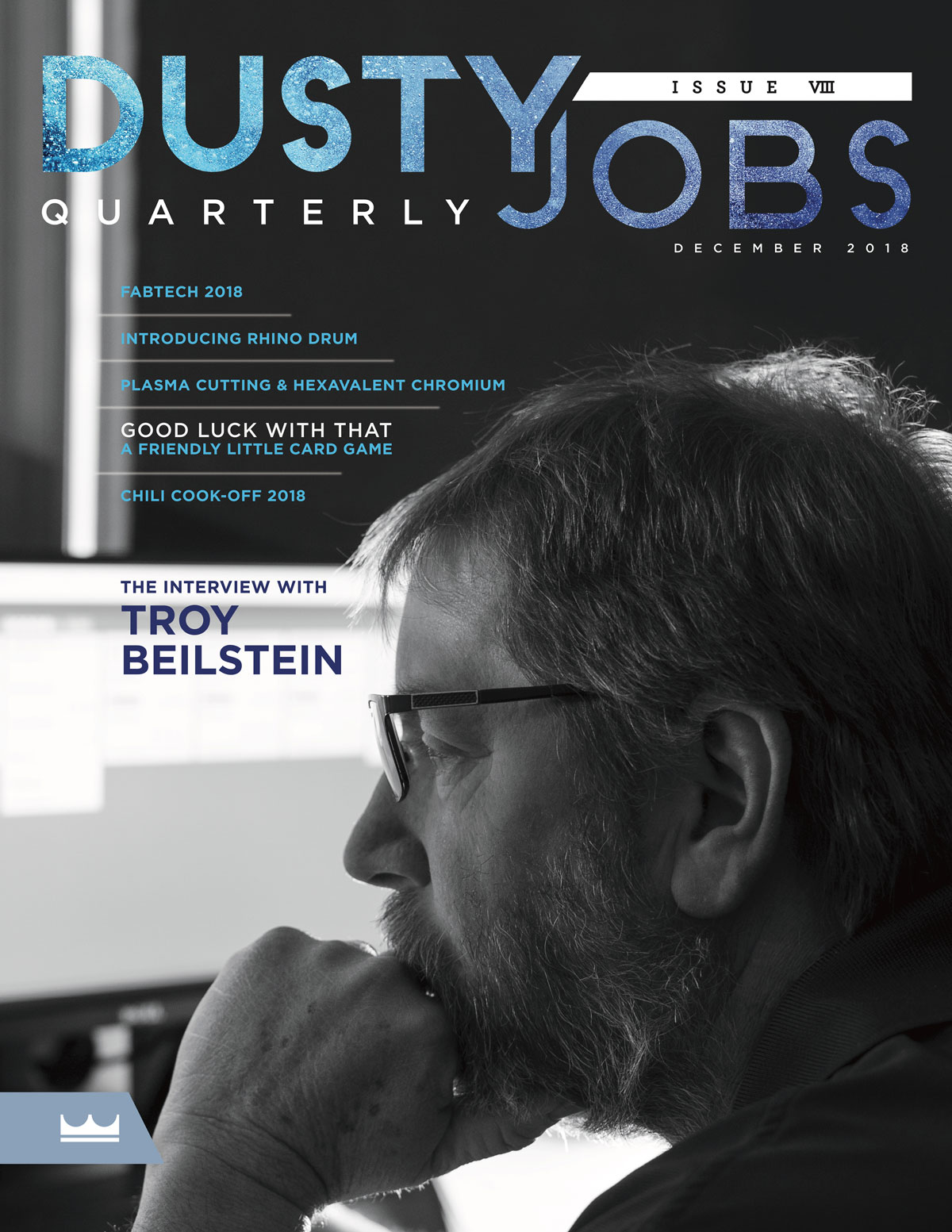
Click the article to read






A Letter from the Director of Sales & Marketing
 Several years ago I had the pleasure of visiting VIR (Virginia International Raceway) in Alton, VA. This is a historic road course originally developed in the 1950s and resurrected in 2000. I was visiting a friend who was CART racing at the time and he invited us to come watch him race. Upon arrival, we were asked if we were interested in a ride around the course. “Sure!” we exclaimed, and then proceeded to pile into a Ford Econoline van with a professional driver behind the wheel. While the spin around the track was fun and even at times exhilarating as this driver pushed the large van to its limits, I couldn’t help but to think that with the right vehicle this trial spin could have been a lot more effective, and fun.
Several years ago I had the pleasure of visiting VIR (Virginia International Raceway) in Alton, VA. This is a historic road course originally developed in the 1950s and resurrected in 2000. I was visiting a friend who was CART racing at the time and he invited us to come watch him race. Upon arrival, we were asked if we were interested in a ride around the course. “Sure!” we exclaimed, and then proceeded to pile into a Ford Econoline van with a professional driver behind the wheel. While the spin around the track was fun and even at times exhilarating as this driver pushed the large van to its limits, I couldn’t help but to think that with the right vehicle this trial spin could have been a lot more effective, and fun.
You might now be thinking, “That’s nice, but what in the world does this story have to do with Imperial Systems?” Let me explain. I came on board as Director of Sales and Marketing for Imperial Systems about seven months ago. Over the years I have worked for a couple of medium size companies and one fairly large international organization approaching $1 billion on total sales. This large company had many great people and great products but, like most large companies, if you wanted to get something done it required a lot of planning, consensus from many, and copious amounts of time. In other words, it was like trying to handle a road race track in a full-size van.
 Imperial Systems has been a refreshing and fun change for me. Like the other companies I have worked with, we have great people, great products and great ideas. The difference is that we have clear, concise and quick discussions and brain storming sessions with ideas that get engineered, tested, and manufactured in a fraction of the time it takes in most companies. I have been a part of this experience for our newest product, The Rhino Drum, along with all of the current improvements we are making to our cartridge line, our flagship CMAXX collector, our BRF Medium Pressure unit, and many others to come. I also witnessed this in our approach to Fabtech in the way in which we created a plan and implemented that plan, which lead to a very successful trade show eliciting many viable leads.
Imperial Systems has been a refreshing and fun change for me. Like the other companies I have worked with, we have great people, great products and great ideas. The difference is that we have clear, concise and quick discussions and brain storming sessions with ideas that get engineered, tested, and manufactured in a fraction of the time it takes in most companies. I have been a part of this experience for our newest product, The Rhino Drum, along with all of the current improvements we are making to our cartridge line, our flagship CMAXX collector, our BRF Medium Pressure unit, and many others to come. I also witnessed this in our approach to Fabtech in the way in which we created a plan and implemented that plan, which lead to a very successful trade show eliciting many viable leads.
At Imperial Systems there is an awareness that we are on that race track and we are surrounded by competitors who want to be first at the finish line. The difference is that we not only have the right drivers but also the right vehicle to ensure we finish first and best. Drivers, start your engines!!
– Tomm Frungillo, Director of Sales & Marketing
Read more
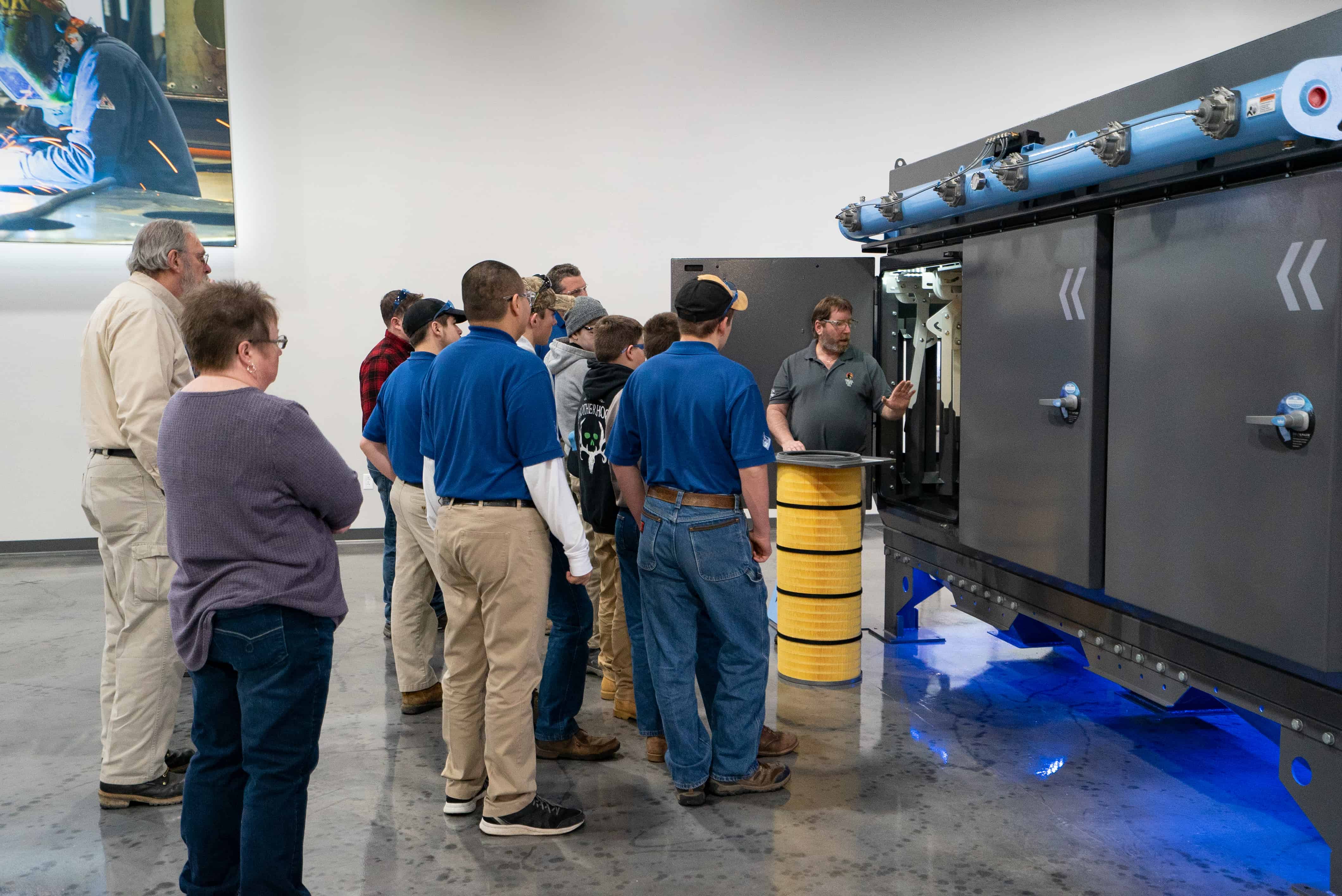
by Erin Long | Mar 5, 2019 | Hidden from Archive
Troy has been a draftsman and engineer at Imperial Systems for more than eleven years. When not at work, he dedicates most of this time to Trail Life USA where he is a Trail Master and mentor. While he doesn’t have time for many other hobbies, he does make a great brisket. He firmly believes in the power of a good meal to bring people together as a team, a tradition the engineering department here at Imperial Systems continue to share.
How long have you been here?
Since August 2007. Eleven and a half years.
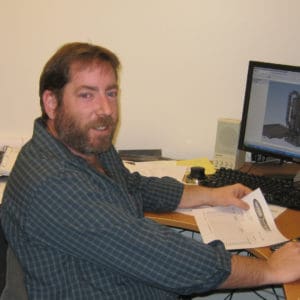 Did you start here as an engineer?
Did you start here as an engineer?
I responded to an ad for a draftsman. It was while they were still at the building in Grove City, and I saw it and didn’t think much of it. Then a little while later one of my friends showed me a big two‑page spread in the Sharon Herald about the new building in Jackson Center. So when they were hiring again, I jumped on it.
How did you get your start as an engineer?
I worked as an electrical draftsman in Sharpsville at first, and I was working on getting my degree. It took a while. By the time I graduated, I would have been sitting at commencement next to the guy that was going to marry my daughter. I took an AUTOCAD course and I basically helped teach the course because I knew so much about it. I got back into 3D drawing and got the 3D bug again.
So when did you officially become an engineer here?
Well, one day I got business cards that said “design engineer” on them, so I figured it was official.
 Outside of work, you dedicate a lot of time to the Boy Scouts, right?
Outside of work, you dedicate a lot of time to the Boy Scouts, right?
It’s actually Trail Life. We started out as Boy Scout troops, and I started working with them around 2001. Around 2014 some of us started to see some changes with the Boy Scouts, and some more changes coming down the pipe, that we didn’t feel like they were in line with our goals.
How did Trail Life get started? What makes it special?
It was formed at a conference in Nashville in 2014. I was really excited about the idea. I sat at my computer and clicked the button until registration opened. We were the first troop to register. It’s a faith-based organization that raises boys to be good Christian men and lead their families and churches. It’s all about men teaching boys how to be men.
What made you so excited about the idea of Trail Life?
I saw a real need for boys to have men to look up to. We need boys that can grow up to be leaders and be active in their community and their church. They need to be able to set a good example for their own kids. I still have respect for the Boy Scouts. My son was a Boy Scout until he got distracted by the fumes… you know, perfume and exhaust fumes.
Does your family have a history with scouting?
My father was an assistant Scout Master and committee member. He started as a Boy Scout from 1944 until the Korean War. He says the Boy Scouts saved his life many times while he was in Korea, using the skills he learned there. This has always been something I’ve been really involved in, and it’s important to me.
What age group do you work with?
I work mostly with boys in 6th, 7th, and 8th grade. I’m the Trail Master for that group. I’m involved with all the groups. When we have the awards banquets, I make brisket for everyone. In February I’m going to be bringing the boys in to talk to everyone who works here, marketing, sales, engineering, fabrication… we have vocational badges where the boys have to learn about the job and find out more about it. It’s important for them to learn what a job is really like so they’ll know if they’re going to like it.
What else do you do when you’re not working with Trail Life?
I don’t really have a lot of time for much else, with the 800 hours I spend away and the few hundred more hours I spend preparing. One trip we wanted to give the boys a chance to shoot guns, so I went and got my NRA instructor and my Range Safety Officer qualifications. My nephews played sports for Lakeview and at Edinboro, so if I couldn’t go to the games I listened to them on the radio. My wife took all the Lakeview sports photos until just recently.
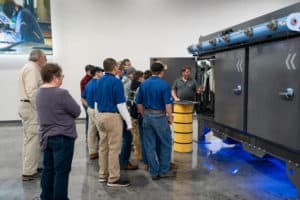 You said you love your job working here.
You said you love your job working here.
One thing I really like, we started when I worked at Packard Electric. I had a gas grill and one of the other guys had one too, and we worked afternoons, so we all got together and cooked for everyone. It really bonded us like family. The afternoon crew went from worst productivity to best.
And you guys still do that here.
We get together and grill or smoke food once a week. We even have our own smoker now. It really helps a group bond, work together better. You get to talk about problems and come up with solutions. It brings us together as a team.
It’s great to hear someone say they love their job.
That’s why the vocational badges are important to me for the boys. I want them to know the details about a job so when they do go out and get jobs, they can do something they love too.
Read more

 About the School and Their Challenge
About the School and Their Challenge In this photo, the diaphragm from a valve clearly has a crack in the material. Although the system appears to be working perfectly, compressed air escapes through this crack. As a result, this dust collector valve is not getting sufficient air. While this might not be a major problem at first, it’s going to become one.
In this photo, the diaphragm from a valve clearly has a crack in the material. Although the system appears to be working perfectly, compressed air escapes through this crack. As a result, this dust collector valve is not getting sufficient air. While this might not be a major problem at first, it’s going to become one. The broken pieces of spring were wreaking havoc inside the valve. They were damaging the valve itself and even starting to scrape and deform the metal parts. The company had no idea this issue was going on because the valves had not failed yet. Fortunately, a routine inspection discovered the broken springs and valve damage. So they replaced the valves before they could fail and wreck the filters. Further, it prevented downtime and thus, more problems.
The broken pieces of spring were wreaking havoc inside the valve. They were damaging the valve itself and even starting to scrape and deform the metal parts. The company had no idea this issue was going on because the valves had not failed yet. Fortunately, a routine inspection discovered the broken springs and valve damage. So they replaced the valves before they could fail and wreck the filters. Further, it prevented downtime and thus, more problems. Valves are just one of many things that a ServiceMAXX technician can check. And a damaged valve like this one highlights the value of routine maintenance. Just like your doctor recommends routine bloodwork to catch problems before you see symptoms or a vehicle inspection can reveal wear and tear on engine parts, a yearly ServiceMAXX maintenance visit can find potential problems and fix them before they start to cost you money.
Valves are just one of many things that a ServiceMAXX technician can check. And a damaged valve like this one highlights the value of routine maintenance. Just like your doctor recommends routine bloodwork to catch problems before you see symptoms or a vehicle inspection can reveal wear and tear on engine parts, a yearly ServiceMAXX maintenance visit can find potential problems and fix them before they start to cost you money.










 Several years ago I had the pleasure of visiting VIR (Virginia International Raceway) in Alton, VA. This is a historic road course originally developed in the 1950s and resurrected in 2000. I was visiting a friend who was CART racing at the time and he invited us to come watch him race. Upon arrival, we were asked if we were interested in a ride around the course. “Sure!” we exclaimed, and then proceeded to pile into a Ford Econoline van with a professional driver behind the wheel. While the spin around the track was fun and even at times exhilarating as this driver pushed the large van to its limits, I couldn’t help but to think that with the right vehicle this trial spin could have been a lot more effective, and fun.
Several years ago I had the pleasure of visiting VIR (Virginia International Raceway) in Alton, VA. This is a historic road course originally developed in the 1950s and resurrected in 2000. I was visiting a friend who was CART racing at the time and he invited us to come watch him race. Upon arrival, we were asked if we were interested in a ride around the course. “Sure!” we exclaimed, and then proceeded to pile into a Ford Econoline van with a professional driver behind the wheel. While the spin around the track was fun and even at times exhilarating as this driver pushed the large van to its limits, I couldn’t help but to think that with the right vehicle this trial spin could have been a lot more effective, and fun. Imperial Systems has been a refreshing and fun change for me. Like the other companies I have worked with, we have great people, great products and great ideas. The difference is that we have clear, concise and quick discussions and brain storming sessions with ideas that get engineered, tested, and manufactured in a fraction of the time it takes in most companies. I have been a part of this experience for our newest product, The Rhino Drum, along with all of the current improvements we are making to our cartridge line, our flagship CMAXX collector, our BRF Medium Pressure unit, and many others to come. I also witnessed this in our approach to Fabtech in the way in which we created a plan and implemented that plan, which lead to a very successful trade show eliciting many viable leads.
Imperial Systems has been a refreshing and fun change for me. Like the other companies I have worked with, we have great people, great products and great ideas. The difference is that we have clear, concise and quick discussions and brain storming sessions with ideas that get engineered, tested, and manufactured in a fraction of the time it takes in most companies. I have been a part of this experience for our newest product, The Rhino Drum, along with all of the current improvements we are making to our cartridge line, our flagship CMAXX collector, our BRF Medium Pressure unit, and many others to come. I also witnessed this in our approach to Fabtech in the way in which we created a plan and implemented that plan, which lead to a very successful trade show eliciting many viable leads.
 Did you start here as an engineer?
Did you start here as an engineer? Outside of work, you dedicate a lot of time to the Boy Scouts, right?
Outside of work, you dedicate a lot of time to the Boy Scouts, right? You said you love your job working here.
You said you love your job working here.